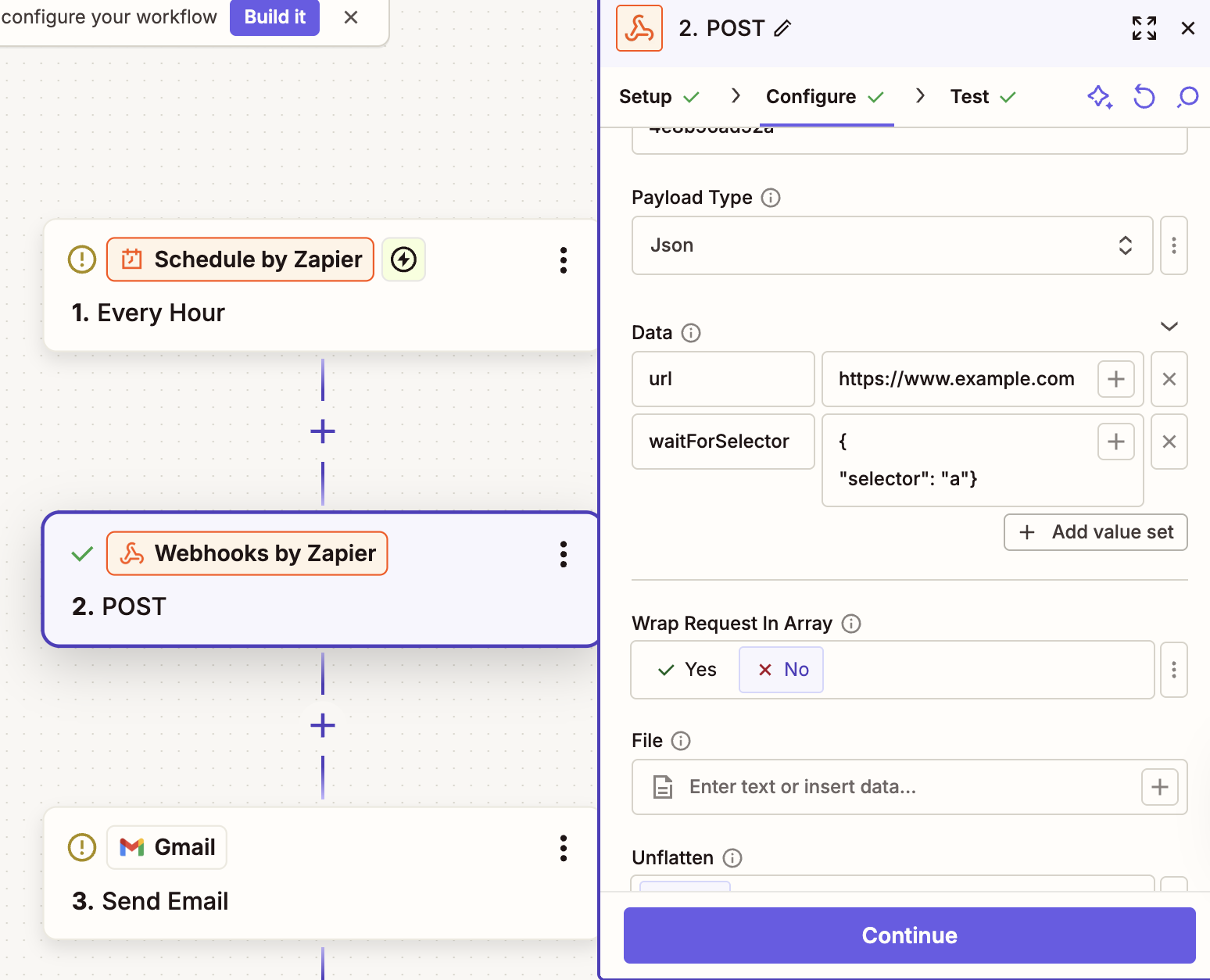Using Browserless with Zapier
Use Zapier to orchestrate Browserless through our REST APIs. This will allow you to tigger real Chrome sessions to take screenshots, generate PDFs, fetch HTML, run BQL flows, or execute custom functions, then pass results to apps like Google Drive, Slack, or Gmail. There are two ways to use Browserless with Zapier:
- Browserless Zapier Integration: our custom app with built‑in actions like Screenshot, PDF, Content, Stats, Scrape, and BQL. No paid Zapier account required.
- Webhooks by Zapier: call Browserless REST/BQL endpoints directly with Webhooks by Zapier which requires a paid Zapier account.
Browserless Zapier Integration
Connect your Browserless account and use prebuilt actions and fill in the required fields.
Connect Browserless
- In Zapier, create a Zap and add the Browserless app as an action.
- Click “Connect a new account”.
- Enter:
- Account Name: any label to recognize your account
- API token: your Browserless API token from the dashboard
- Zapier will verify the token by calling the Browserless version endpoint.
Built-in REST APIs
- Screenshot: capture a screenshot from a URL.
- PDF: generate a PDF from a URL.
- Content: fetch rendered HTML/content from a URL.
- Scrape: scrape data from a URL.
- Stats: retrieve account stats.
- BQL: run multi‑step BrowserQL flows.
Each action exposes “Quick Options” (URL, waitUntil, flags) and an “Advanced - Raw JSON” input that overrides quick options if you define the full JSON body.

Webhooks by Zapier
Leverage Webhooks by Zapier to run our REST APIs as you would with any HTTP Request and implement our REST APIs directly.
Webhooks by Zapier requires a paid Zapier account.
For the templates below, remember to replace YOUR_API_TOKEN_HERE with your actual Browserless API token.
Example workflow: Daily Visual Check
Trigger — Schedule by Zapier: run every hour
Action — Webhooks by Zapier (POST):
- URL:
https://production-sfo.browserless.io/screenshot?token=YOUR_API_TOKEN_HERE&headless=false&stealth=true&--window-size=1440,1000&--lang=en-US - Payload (JSON):
{
"url": "https://www.ebay.com/sch/i.html?_nkw=nintendo+switch",
"options": {
"fullPage": true,
"type": "png",
"viewport": { "width": 1440, "height": 1000 }
}
}
Optional — Gmail (Send Email): attach the file taken from browserless.

Implementing REST APIs
You can implement all our REST APIs using Webhooks by Zapier as documented below. Zapier has an AI Beta "Copilot", you can copy paste the below information and it'll configure the webhook for you.
Screenshot
Use Webhooks by Zapier → POST to /screenshot for visual monitoring, thumbnails, and documentation images.
Zapier Webhook POST Configuration
- Add Webhooks by Zapier to your Zap
- Choose POST as the event
- Set URL to
https://production-sfo.browserless.io/screenshot?token=YOUR_API_TOKEN_HERE - Set Payload Type to
JSON - Add these data fields:
url:https://www.example.com
Learn more about the Screenshot API
PDF Generation
Use Webhooks by Zapier → POST to /pdf for printable reports and archival documents.
Zapier Webhook POST Configuration
- Add Webhooks by Zapier to your Zap
- Choose POST as the event
- Set URL to
https://production-sfo.browserless.io/pdf?token=YOUR_API_TOKEN_HERE - Set Payload Type to
JSON - Add these data fields:
url:https://www.example.com
Content Extraction
Use Webhooks by Zapier → POST to /content for rendered HTML analysis and web scraping.
Zapier Webhook POST Configuration
- Add Webhooks by Zapier to your Zap
- Choose POST as the event
- Set URL to
https://production-sfo.browserless.io/content?token=YOUR_API_TOKEN_HERE - Set Payload Type to
JSON - Add these data fields:
url:https://www.example.com
Learn more about the Content API
Unblock
Use Webhooks by Zapier → POST to /unblock for bypassing anti-bot measures and accessing protected content.
Zapier Webhook POST Configuration
- Add Webhooks by Zapier to your Zap
- Choose POST as the event
- Set URL to
https://production-sfo.browserless.io/unblock?token=YOUR_API_TOKEN_HERE - Set Payload Type to
JSON - Add these data fields:
url:https://www.example.comcookies:truebrowserWSEndpoint:truecontent:truescreenshot:true
Learn more about the Unblock API
Browser Query Language (BQL)
Use Webhooks by Zapier → POST to /chrome/bql for multi-step BrowserQL automation workflows.
Zapier Webhook POST Configuration
- Add Webhooks by Zapier to your Zap
- Choose POST as the event
- Set URL to
https://production-sfo.browserless.io/chrome/bql?token=YOUR_API_TOKEN_HERE - Set Payload Type to
JSON - Add these data fields:
query:mutation FormExample {\n goto(url: \"https://www.browserless.io/practice-form\") {\n status\n }\n select(selector:\"#Contact-Subject\",value:\"support\"){ time } \n typeEmail: type(text: \"john@email.com\", selector: \"#Email\") {\n time\n }\n typeMessage: type(\n selector: \"#Message\"\n text: \"Hello world!\"\n ) {\n time\n }\n solve(\n type: cloudflare\n ){\n solved\n }\n waitForTimeout(time:3000){time}\n screenshot{\n base64\n }\n}variables:{}operationName:FormExample
Function
Use Webhooks by Zapier → POST to /function for custom JavaScript execution in a real browser context.
Zapier Webhook POST Configuration
- Add Webhooks by Zapier to your Zap
- Choose POST as the event
- Set URL to
https://production-sfo.browserless.io/function?token=YOUR_API_TOKEN_HERE - Set Payload Type to
Raw - Set Content Type to
application/javascript - Add this JavaScript to the Data field:
export default async function ({ page }) {
await page.goto("https://example.com/");
const url = await page.content();
const buffer = await page.pdf({ format: "A4" });
const base64PDF = buffer.toString('base64');
const screenshot = await page.screenshot({ encoding: "base64" });
return {
data: {
url,
screenshot,
base64PDF
},
type: "application/json",
};
}